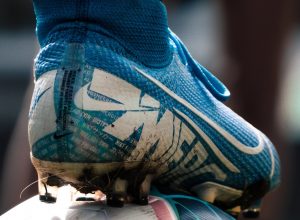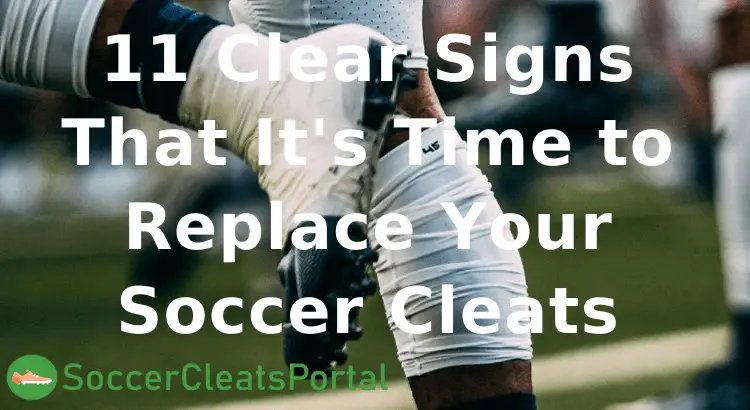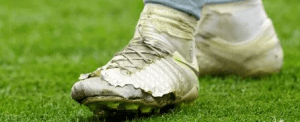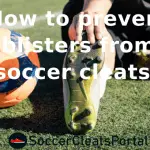When we get used to a pair of good soccer cleats, they tend to feel like an extension of our legs. However, time catches up to everything, and your favorite soccer shoes are no exception, of course. They are made from soft and light materials which will eventually get damaged and there will be a need to buy a new pair. So, what are the main signs that your soccer cleats became obsolete?
11 Clear Signs That It’s Time to Replace Your Soccer Cleats
1. Your boots are getting uncomfortable.
After extensive use your shoes are starting to get either too tight or too stretched.
Cleaning and drying your shoes many times means that the leather in the upper gets shrinking. Also the shoe might get stretched after too many playing sessions.
Also the inside of your shoe along with the insoles will start to wear down. That will lead to unpleasant feeling of the studs pushing on your foot. You can try to change the insoles, but this is a clear sign that you will need new shoes any time soon.
2. Your Cleats Don’t Offer Enough Protection Anymore.
If the inner part of your soccer cleats gets thinned out, you will lack protection when playing. Soccer is a physical sport, and it can be quite dangerous when someone steps on your shoe. Also, the bottom part of old cleats is usually worn out, and you may experience some pain in your heels or soles. If your socks give you more protection than your soccer cleats, it’s probably time to do some shopping.
3. The studs are getting ripped.
If you are walking or playing on hard surfaces, the studs will wear down eventually. That will cause you to lose your grip and stability in the field and that can result in an injury.
4. Some Crackling Noises Appear.
After years of use, the leather inside the shoe will dry up. If you took proper care of your cleats, this process will be postponed a bit.
However, after a certain time, the shoe’s materials will still begin to deteriorate. This can especially be noticed when you bend the forefoot of your cleats and hear some unpleasant crackling noises.
5. Your Cleats Look Nicer When They Are Dirty. 
When the uppers on your cleats get worn out, the dirt and mud will actually help in covering parts that are damaged. When you give your shoes a thorough cleaning, you will notice this right away. It’s a clear sign that you need to get yourself a new pair.
6. It’s Hard to Tie Your Shoelaces.
If the eyelets on your soccer cleats get torn up, you are going to have to prepare a shoelace tieing strategy. Wrapping them around or under your foot can solve the issue for a few games, however, it will become problematic eventually. You can even trip or hurt your ankle if the damage becomes too large. It’s better to search for a replacement.
7. You Can’t Get Rid of Unpleasant Smells.
This is usually fixable, and there are a bunch of methods to eliminate all the smells from your soccer cleats. However, sometimes your shoes are so old and battered that the smell is just one of the symptoms of shoes in need of a replacement.
8. You Need to Repair Your Cleats a Lot.
Many players like their cleats so much that they’ll try to fix them with some tape or glue. This can work sometimes, but if your shoes become uncomfortable or lose functionality, it’s time to consider replacing them. There is a risk of injury, and your play could get much worse. Also, if they break apart during a game, you may not have a spare pair to play in.
If you need more tape for your shoes than your ankles, then it’s time to get new shoes.
9. You Bought Them Ages Ago
If you can hardly remember the time and place where you purchased your shoes, they are likely ripe for a replacement. It may be time to change your favorite pair for something new. Of course, if you didn’t use them much they could still be fully functional.
10. You Are Still Growing
If you’re still young and your body is developing, chances are that you’ll have to replace your shoes very often. Your foot keeps growing at an astonishing rate until you’re twelve. After this, the growth rate slows down, but you can still expect your foot to increase in size. Just keep an eye on the comfort of your shoes. If they get too tight, it’s time for a new purchase.
11. You want to freshen up your look.
With so many new model releases, it is natural to want to replace your old pair with a new one. Or in some cases, you may want to change to cleats that offers better ankle protection.
New models offer some extra features to soccer players and many are lured the replace their old pair with a new one.
How Often Should Soccer Cleats be Replaced?
The answer to this question mostly depends on the level of the soccer competition. If you play in low-tier leagues, changing them once a season is the suggested norm. However, if you feel that your cleats still have some fuel left in them, you can always stretch out this period and wear them for two years.
Furthermore, if your budget isn’t that large, you can always postpone the replacements when your cleats seem to be in good condition.
In higher soccer leagues, cleats should be replaced more often. At the semi-pro level, you should aim to change them twice per season. However, for players in lower leagues, it would probably be a waste of money as you aren’t getting paid for playing. In amateur leagues, you should be fine with deciding on replacing your cleats depending on how they fare.
Professionals that play in the highest leagues change them as much as 4 times a year. This is because they play a huge number of very competitive games, and they have to train a lot. Also, these players can afford to change their footwear frequently.
At the lowest level of soccer, the pitches are notorious for being muddy and bumpy. This can take a toll on your shoes in no time so that deterioration rates can vary.
The material of the soccer cleats is an important factor here. Sometimes, pricier shoes will have a shorter lifespan, because they are made of more sophisticated components. Players prefer lightweight soccer cleats, but they are also the quickest to become worn out.
You should also take into account that when you use the same pair of shoes for training and playing games, your cleats wear out much faster.
The frequency of replacing your soccer cleats is mostly dependent on the time you spend using them, of course. When you don’t participate in any competitions and just want to play for fun with your friends, you can change your cleats only when they get very damaged and affect your play.
How Long Do Soccer Cleats Last?
At the top playing level, soccer cleats can last from 6 months up to a year. Despite this, they are usually changed more often. In the lower leagues, the number of replacements can vary. This depends on the number of games and training sessions during the week. It’s important to notice that soccer shoes can last for a long time before they become unwearable. The problem is that they tend to become uncomfortable and can affect your playstyle. Here are the main factors that determine the lifespan of an average soccer cleat:
1. Shoe’s Durability
The material of the soccer cleats is the main factor here. Mid-tier shoes should last a bit longer than the more expensive models as they are made from more durable fabrics. However, they will be a bit less comfortable and weigh more. The pricier models are thin and light, which means that they get torn up more easily.
2. Time Spent Playing
Time spent using your soccer cleats is probably the most important factor when determining how long they will last. If you go to play soccer just once or twice a week, your shoes could show signs of being damaged only after many years. On the other hand, if you play every single day, your cleats will be tattered in a matter of months. You can slow down this process a bit by using one pair of shoes for training and a separate pair for your games.
3. Playing Surface
When you play on a nice and flat surface, your soccer cleats should take the least amount of damage. However, this is not always the case. The terrain on soccer fields is often uneven and rough. When there is some rain, your shoes will get wet and muddy, which could also affect them in the long run. Having to dry your cleats a lot will make the leather dry up faster.
All in all, if you aren’t a professional player, you should be alright with changing your soccer cleats once every one or two seasons. For casual players, it’s best to rely on how comfortable your cleats are, and change them only when you feel that it’s necessary.




